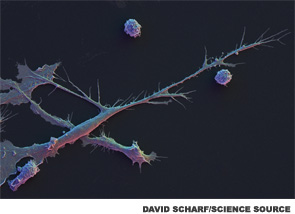
The current T cell maturation paradigm assumes that, in a healthy body, self-reactive T cells are deleted or inactivated in the thymus. This would be especially true for T cells that react to antigens expressed throughout the body. This model of thymic education would predict that autoreactive T cells would be difficult to find, and, indeed, this is the case. Many autoimmune diseases, however, are mediated by T cells and, presumably mediated by self-reactive T cells. These autoreactive T cells must somehow be able to escape thymic selection and circulate through the body in order to mediate autoimmune diseases such as rheumatoid arthritis (RA).
A new investigational strategy provides a means to identify and characterize autoreactive T cells that escape thymic selection and cause autoimmunity. The novel approach to T cell analysis was published by Yoshinaga Ito, PhD, assistant professor of experimental pathology at Kyoto University in Japan, and colleagues in the Oct. 17 issue of Science.1
The Mouse Model
The group has previously demonstrated that attenuated signaling through the T cell receptor (TCR) alters thymic T cell selection and regulatory T cell function. They performed their research using BALB/c SKG mice that have a hypomorphic point mutation of zeta-chain associated protein 70 (ZAP-70), a TCR-proximal signaling molecule. The resultant altered signaling through the TCR compromises the thymic selection of the T cells in the mice, leading to positive selection of autoimmune T cells that would otherwise be negatively selected. SKG mice thus go on to develop T cell-mediated spontaneous autoimmune arthritis and can serve as a mouse model for RA. Through their study of the SKG mice, the investigators concluded that the mice represent a model for the ability of a genetic mutation in TCR signaling to contribute to the development of an autoimmune disease. Moreover, the group hypothesized that they had identified an underlying mechanism of autoimmune disease whereby graded attenuation of TCR signaling can alter the T cell repertoire in a progressive manner, thus predisposing an individual to autoimmune disease.
‘Our results show that by attenuating TCR signal intensity in developing T cells (hence reducing their sensitivity to thymic negative selection by natural self ligands), T cells reactive with ubiquitously expressed self antigens can be generated as dominant pathogenic clones causing systemic autoimmune disease.’
Focus on the T Cell Receptor
In the current study, the team continued to make use of the SKG mice with the altered TCR signaling. They began their study with the assumption that the ZAP-70 mutation changed the T cell sensitivity to thymic negative selection, thereby allowing autoreactive T cells to be produced by the thymus, persist in the body, and create symptoms of arthritis. The investigators thus set about isolating the arthritogenic TCRs and characterizing the self antigens that they recognized. Their experiments revealed that the arthritogenic CD4+ T helper cells in these mice made use of specific dominant TCRs.
In particular, the investigators identified two dominant autoreactive TCRs: TCR 7-39 and TCR 6-39. They then transferred the genes for the TCR 7-39 and TCR 6-39 into Rag2-/- mice, which lack mature T and B cells. They, thus, engineered retrogenic 7-39 (R7-39) Rag2 -/- and R6-39 mice that were populated with 7-39 and 6-39 TCR-transduced cells, respectively. Both mice strains spontaneously developed arthritis. The investigators next transferred T cells from the R7-39 mice into Rag2-/- mice and demonstrated that the autoreactive T cells were able to transfer both arthritis and dermatitis. The authors concluded that CD4+ T cells with a specific TCR mediate autoimmune arthritis and dermatitis in mice.
Ubiquitous Cellular Protein
The researchers next created T cell hybridomas that expressed either the 7-39 TCR or the 6-39 TCR. They used the hybridomas to identify the target self antigen. They found that the 7-39 TCR recognized the ubiquitously expressed 60S ribosomal protein L23a (RPL23A). The 6-39 TCR did not, however, bind to peptides derived from RPL23A. The authors hypothesized from this that RPL23A is one of the target antigens in patients with arthritis as well as dermatitis. Their results also suggest that more than one systemic antigen can underlie the induction of arthritis.
The investigators demonstrated that RPL23A was able to stimulate CD4+ T cells in the mice via RPL23A-derived peptide-MHC class II complexes. In addition, transfer of CD4+ T cells, but not sera from B cell-reconstituted R7-39 mice, was able to induce arthritis in Rag2-/- mice. Regulatory T (Treg) cells from either regular BALB/c mice or BALB/c SKG mice were not able to suppress the development of arthritis when cotransferred with 7-39 TCR+ CD4+ T cells.
The team next examined the role of RPL23A in humans. They found that RPL23A mRNA was ubiquitously expressed in healthy human tissues. Moreover, T cells and autoantibodies from patients with RA reacted to the RPL23A antigen.
“Our results show that by attenuating TCR signal intensity in developing T cells (hence reducing their sensitivity to thymic negative selection by natural self ligands), T cells reactive with ubiquitously expressed self antigens can be generated as dominant pathogenic clones causing systemic autoimmune disease. Because similar attenuation of TCR signaling at various degrees in conjunction with Treg cell depletion is able to produce a variety of other autoimmune diseases in mice, this strategy of generating pathogenic T cells and characterizing the self antigens they recognize would facilitate our understanding of the mechanisms of other autoimmune diseases of currently unknown etiology. In addition, given that genetic polymorphism in a signaling molecule in T cells is a major determinant of genetic susceptibility to various human autoimmune diseases including RA, such a genetic variation might, at least in part, alter thymic selection, hence forming a TCR repertoire for causing autoimmune disease,” wrote the authors in their paper.
Lara C. Pullen, PhD, is a medical writer based in the Chicago area.
Reference
- Ito Y, Hashimoto M, Hirota K, et al. Detection of T cell responses to a ubiquitous cellular protein in autoimmune disease. Science. 2014 Oct 17;346(6207):363–368.